Charing Cross Bridge (Monet series)
Charing Cross Bridge is a series of oil paintings by French artist Claude Monet. The paintings depict a misty, impressionist Charing Cross Bridge in London, England. Monet worked on the series from 1899 to 1905, creating a total of 37 paintings depicting the bridge.[1]

While all of the paintings in the series depict the same bridge, each has unique qualities. For instance, Monet uses different color combinations to portray different atmospheric conditions. In some paintings, Monet includes details such as trains, clock towers, and boats, but omits such features in others.[2]
Today, the Charing Cross Bridge paintings are scattered in museums around the world. These include the Art Institute of Chicago,[3] the Baltimore Museum of Art,[4] the Museum of Fine Arts, Boston,[5] the Art Gallery of Ontario[6] and the Thyssen-Bornemisza Museum in Madrid.[7]
Context
Under exile during the Franco-Prussian War, Monet travelled to London for the first time in 1870.[8] He became enthralled with the city, and vowed to return to it someday. Monet's fascination with London lay primarily in its fogs,[9] a byproduct of the Industrial Revolution. Writers hypothesize that Monet was also inspired by contemporaries J. M. W. Turner and James Abbott McNeill Whistler, who were similarly fascinated by London's atmosphere.[2][9] Thus, in 1899, Monet returned to London and rented a room in the Savoy Hotel, which offered an extensive viewpoint from which to begin his series of the city.[8]
Between 1899 and 1905, Monet periodically travelled to London to work on the series.[8] He completed 37 paintings of the Charing Cross Bridge in total. In addition to painting the bridge, Monet painted other landmarks, such as the Houses of Parliament and Waterloo Bridge. While Monet began all of the paintings in London, he completed many of them in his studio in Giverny, France. As a result, some critics question whether the paintings are completely accurate.[1] On the other hand, recent analyses of solar positioning report that Monet's paintings "contain elements of accurate observation and may potentially be considered as a proxy indicator for the Victorian smogs and atmospheric states they depict."[1]
Description

Each of the 37 paintings shares common features. Across the horizon, Monet portrays the Charing Cross Bridge using thin lines.[2] Although the bridge is consistent across his paintings, it is not entirely representative of the actual bridge. John Sweetnam explains, "Comparisons with the actual bridge show that Monet compressed the solid and open parts of the deck into a mass that is both more consolidated and more extreme in its horizontally."[2]
Although the paintings share much in common, they also have notable differences. In certain versions, Monet includes an obscured train that blows smoke as it travels across the bridge.[2] Some paintings depict a small boat in the bottom left corner; others depict Big Ben and the Victoria Tower in the top right corner. The towers are shadowy outlines at best, leading Rebecca Stern to suggest that Monet "obscures all record of standardized time in his series.”[10]
Interpretation
In this series, Monet represents the same subject in various conditions of light and atmosphere. Specifically, Monet was both captivated and challenged by the ways in which the ever-changing London fog affected the appearance of the bridge.[2] In each of the paintings, Monet surrounds the bridge with enveloppe, a term that he himself defined as "the same light spread over everything."[11] John House further describes this concept, writing that this "colored atmospheric cloak... allowed... [Monet] to give his paintings, both singly and when exhibited in groups, the internal coherence and unity he sought."[12] Indeed, Monet experimented with ambience throughout his career, as seen in his Haystacks, Rouen Cathedral, and Water Lillies series.[13]
In addition to building upon his previous work, Monet builds upon the foundation laid by his contemporaries. Like Turner, Monet was intrigued by the interplay between subject matter and the outer, natural world. Sweetnam argues, "Charing Cross Bridge with its passing trains made up a subject in which subject content and light, as in Turner, were totally merged."[2] Besides Turner's work, the Charing Cross Bridge series also parallels Whistler's work. In his Nocturne paintings, Whistler advocated for and succeeded in making London an acceptable subject of paintings. While Monet also sought to represent London in his paintings, he did not represent the city in the same muted colors that Whistler used. House views Monet's approach as "very different from that of his contemporaries... Monet's mists are suffused with delicate yet endlessly varied harmonies of colour."[9]
Gallery
Eight of the paintings in the Charing Cross Bridge series:
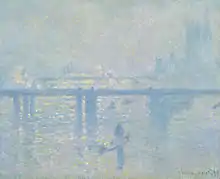 Charing Cross Bridge, 1899, Thyssen-Bornemisza Museum, Madrid
Charing Cross Bridge, 1899, Thyssen-Bornemisza Museum, Madrid.jpg.webp) Charing Cross Bridge, c. 1899–1901, private collection
Charing Cross Bridge, c. 1899–1901, private collection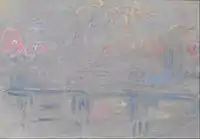 Charing Cross Bridge, c. 1900, Indianapolis Museum of Art
Charing Cross Bridge, c. 1900, Indianapolis Museum of Art.jpg.webp) Charing Cross Bridge, London, 1899–1901, Saint Louis Art Museum
Charing Cross Bridge, London, 1899–1901, Saint Louis Art Museum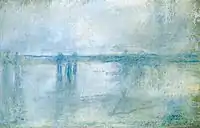 Charing Cross Bridge, London, 1901, Rotterdam police
Charing Cross Bridge, London, 1901, Rotterdam police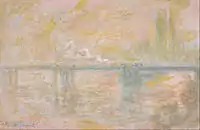 Charing-Cross Bridge in London, c. 1902, National Museum of Western Art, Tokyo
Charing-Cross Bridge in London, c. 1902, National Museum of Western Art, Tokyo Charing Cross Bridge, 1903, Museum of Fine Arts of Lyon
Charing Cross Bridge, 1903, Museum of Fine Arts of Lyon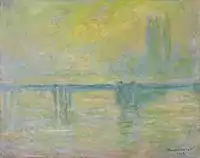 Charing Cross Bridge, Fog, 1902, Art Gallery of Ontario
Charing Cross Bridge, Fog, 1902, Art Gallery of Ontario
See also
References
- Baker, Jacob; Thornes, John E (2006-12-08). "Solar position within Monet's Houses of Parliament". Proceedings of the Royal Society A: Mathematical, Physical and Engineering Sciences. 462 (2076): 3775–3788. Bibcode:2006RSPSA.462.3775B. doi:10.1098/rspa.2006.1754. S2CID 129004829.
- Sweetman, John (2019-05-23). The Artist and the Bridge 1700–1920. doi:10.4324/9780429440083. ISBN 9780429440083.
- "Charing Cross Bridge, London, 1901". Art Institute of Chicago. Retrieved 29 November 2012.
- "Charing Cross Bridge". Baltimore Museum of Art. Archived from the original on 7 January 2011. Retrieved 29 November 2012.
- "Charing Cross Bridge (overcast day), 1900". Museum of Fine Arts, Boston. Retrieved 29 November 2012.
- "Claude Monet, Charing Cross Bridge, Fog". Art Gallery of Ontario. Retrieved 29 November 2012.
- "Claude Monet Charing Cross Bridge 1899". Thyssen-Bornemisza Museum. Archived from the original on 18 December 2014. Retrieved 29 November 2012.
- Khan, Soraya; Thornes, John E.; Baker, Jacob; Olson, Donald W.; Doescher, Russell L. (2010). "Monet at the Savoy". Area. 42 (2): 208–216. doi:10.1111/j.1475-4762.2009.00913.x. ISSN 1475-4762.
- House, John (1991). Monet (3rd ed.). London: Phaidon. ISBN 0-7148-2723-1. OCLC 28061909.
- Stern, Rebecca (2009-09-18). "Time Passes". Narrative. 17 (3): 235–241. doi:10.1353/nar.0.0031. ISSN 1538-974X. S2CID 201791670.
- House, John, 1945-2012. (1986). Monet, nature into art. New Haven: Yale University Press. ISBN 0-300-03785-6. OCLC 15285012.CS1 maint: multiple names: authors list (link)
- House, John, 1945-2012. (1986). Monet, nature into art. New Haven: Yale University Press. ISBN 0-300-03785-6. OCLC 15285012.CS1 maint: multiple names: authors list (link)
- Pelfrey, Robert H. (1985). Art and mass media. Hall-Pelfrey, Mary. (1st ed.). New York: Harper & Row. ISBN 0-06-045112-2. OCLC 12161940.
External links
![]() Media related to Hungerford Bridge by Claude Monet at Wikimedia Commons
Media related to Hungerford Bridge by Claude Monet at Wikimedia Commons